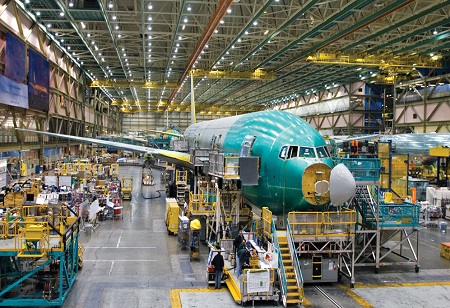In the last one decade, there has been a rapid rise in air passenger traffic and increase in the exports and imports of goods which leads to drive the growth of
Aerospace Parts Manufacturing market. Another reason for fuelling market demand is lightweight and fuel efficient aircraft demand is increasing. Aerospace Parts Manufacturing market size was valued at USD 1 trillion in 2020 and is projected to reach USD 1.36 trillion by 2028 registering a CAGR of 3.95 per cent from 2021 to 2028.
“With global
aerospace manufacturers including Boeing and Airbus looking to Indian companies for components, there is a bit of India in many commercial and defence planes crisscrossing the world”, says Udyant Malhoutra, Managing Director, Dynamatic Technologies. The market of aerospace parts manufacturing has observed a trend of a collaboration of the major companies entering into a joint venture. This helps the companies to sustain in the highly competitive market in terms of geographical expansion, technological advancements and lowering the risk of failure. This also aids the companies to easily access the market for gaining long term contracts.
Lightweight Components
There is an increasing emphasis to scale back total aircraft weight by using lightweight parts attempting to enhance its energy efficiency is probably going to possess a positive impact on market growth. Increasing demand for aerospace parts like surveillance aircraft also as fighter, due to rising security threats is anticipated to positively impact the expansion over the forecast period.
Focus on Autonomous Flight Systems
Focus on Autonomous flight systems is another trend which is being followed by aerospace parts manufacturers. To develop fully autonomous aerospace, engineers are performing closed loop simulations between the sensors, control software and intelligent algorithms. Virtual realities and multi-physics simulation is the only way to test these autonomous aerospace systems to react to all possible situations in a reasonable timeframe.
In the present situation, there has been a rise in the demand for advanced composite materials for the manufacturing of innovative fighter planes which is ultimately aiding the market growth of aerospace parts.
In addition to that, there is an increase in demand for aerospace parts from North Atlantic Treaty Organisation (NATO) countries for surveillance aircraft as well as fighter aircraft, owing to increasing security threats. Central government is also taking initiatives in space exploration activities which are expected to increase the growth of the aerospace parts manufacturing. Furthermore, increasing demand for drones and UAVs is also creating lots of opportunities for manufacturers in this space.
Increasing Digitalisation
Most of the aerospace parts manufacturers have decided to adjust their operations to achieve maximum flexibility with modernisation investments spanning the entire organisation. These initiatives might include simple process and product designs or on a larger scale, ramping up digital technology before, during and after manufacturing. Many companies are now refining their legacy designs to produce new components often at a quicker pace.
As more and more companies embrace new levels of digitalisation, the risk of wasting time or making mistakes is alleviated by moving away from paper based production and manual processes. While shifting to digital, manufacturers are ensuring that they are making wise choices rather than easy ones. Manufacturers are willing to look wider than the monolithic enterprise solution providers they have been working with, as there could be more innovative, appropriate solutions in the wider market.
Smart Materials
According to a recent survey, it is found that the global market of smart materials used in aerospace manufacturing is expected to be valued at USD 98.2 billion by 2025. Industry experts believe that opportunities and scope for innovation with smart materials are vast and revolutionary be it electronic sensors, actuators, self-healing fuselages and more. These smart materials can improve the durability of modern aircraft, proving resistant to conditions that typically damage electric motors.
3D Printing Technology
3D Printing has been there in the industry since a long time but there has not been a high adoption rate in the Aerospace Industry. In the recent years, 3D Printing has brought a new revolution in the sector of Aerospace Parts Manufacturing. This technique makes it possible to create customised parts from nearly any location and to do so with stronger and lighter designs that consume fewer materials. 3D printing has become increasingly apparent as it has matured and can play a vital role in aerospace parts manufacturing. 3D Printing enable engineers to create enhanced, better designs while reducing risk. This technique has integrated, high fidelity models that are now being shared across all technical disciplines and programme partners.
The Way Forward
With industry transformation rapidly gaining momentum, the new techniques to manufacture aerospace parts will keep on adding in the coming future. While Aerospace Parts Manufacturing has entered a new era of digital disruptors driving innovation, digital technology will be maturing rapidly to meet these new requirements and demands. Also, many new methodologies will create a new precedent of engineering design while delivering new levels of control over the entire production process establishing new levels of collaboration between engineering and production teams.
